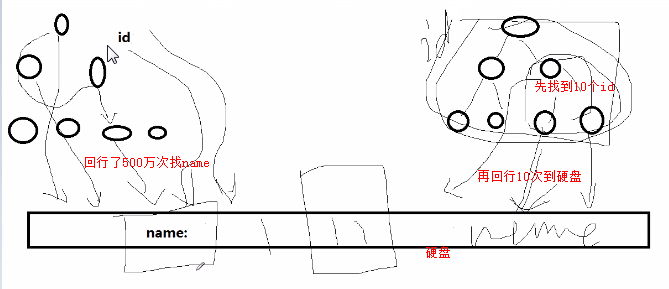理想的索引,高效的索引建立考虑: 1:查询频繁度(哪几个字段经常查询就加上索引) 2:区分度要高 3:索引长度要小 4: 索引尽量能覆盖常用查询字段(如果把所有的列都加上索引,那么索引就会变得很大) 1: 索引长度直接影响索引文件的大小,影响增删改的速度,并间接影响查询速度(占用内存多). 针对列中的值,从左往右截取部分,来建索引 1: 截的越短, 重复度越高,区分度越小, 索引效果越不好 2: 截的越长, 重复度越低,区分度越高, 索引效果越好,但带来的影响也越大--增删改变慢,并间影响查询速度. 所以, 我们要在 区分度 + 长度 两者上,取得一个平衡. 惯用手法: 截取不同长度,并测试其区分度, mysql> select count(distinct left(word,6))/count(*) from dict; +---------------------------------------------------+ | count(distinct left(word,6))/count(*) | +---------------------------------------------------+ | 0.9992 | +---------------------------------------------------+ 1 row in set (0.30 sec)

对于一般的系统应用: 区别度能达到0.1,索引的性能就可以接受.
2:对于左前缀不易区分的列 ,建立索引的技巧
如 url列http://www.baidu.com,http://www.zixue.it,列的前11个字符都是一样的,不易区分, 可以用如下2个办法来解决。
1: 把列内容倒过来存储,并建立索引
Moc.udiab.www//:ptth
Ti.euxiz.www//://ptth
这样左前缀区分度大,
2: 伪hash索引效果,存一个伪哈希列,把字符串转成整形降低索引长度。
同时存 url_hash列
explain select * from t9 where url=’http://www.baidu.com’ G
mysql> select crc32('http://wwww.baidu.com.cn');
+-----------------------------------+
| crc32('http://wwww.baidu.com.cn') |
+-----------------------------------+
| 3865391929 |
+-----------------------------------+
索引长度key_len:50,
mysql> select * from t41 where crcstr=3865391929;
大数据下的分页: limit 及翻页优化,limit offset,N, 当offset非常大时, 效率极低, 原因是mysql并不是跳过offset行,然后单取N行, 而是取offset+N行(跳过100万行,就是返回100万行,然后返回n行,再把其他的行扔掉) 效率较低,当offset越大时,效率越低 mysql> select * from emp limit 1000000,3; +---------+--------+----------+-----+------------+---------+--------+--------+ | empno | ename | job | mgr | hiredate | sal | comm | deptno | +---------+--------+----------+-----+------------+---------+--------+--------+ | 1100002 | JItXJo | SALESMAN | 1 | 2018-01-05 | 2000.00 | 400.00 | 266 | | 1100003 | LdkQxP | SALESMAN | 1 | 2018-01-05 | 2000.00 | 400.00 | 347 | | 1100004 | YOcUrZ | SALESMAN | 1 | 2018-01-05 | 2000.00 | 400.00 | 460 | +---------+--------+----------+-----+------------+---------+--------+--------+ 3 rows in set (0.48 sec) mysql> select * from emp limit 3000000,3; +---------+--------+----------+-----+------------+---------+--------+--------+ | empno | ename | job | mgr | hiredate | sal | comm | deptno | +---------+--------+----------+-----+------------+---------+--------+--------+ | 3100002 | HsQcNK | SALESMAN | 1 | 2018-01-05 | 2000.00 | 400.00 | 106 | | 3100003 | TOpgMq | SALESMAN | 1 | 2018-01-05 | 2000.00 | 400.00 | 202 | | 3100004 | XHtWAN | SALESMAN | 1 | 2018-01-05 | 2000.00 | 400.00 | 143 | +---------+--------+----------+-----+------------+---------+--------+--------+ 3 rows in set (1.11 sec) 当跳过数量过多时,时间就长了。 优化办法: 1: 从业务上去解决 办法: 不允许翻过100页 以百度为例,一般翻页到70页左右. 1:不用offset,用条件查询. 例: mysql> select id,name from lx_com limit 5000000,10; +---------+--------------------------------------------+ | id | name | +---------+--------------------------------------------+ | 5554609 | 温泉县人民政府供暖中心 | .................. | 5554618 | 温泉县邮政鸿盛公司 | +---------+--------------------------------------------+ 10 rows in set (5.33 sec) mysql> select id,name from lx_com where id>5000000 limit 10; +---------+--------------------------------------------------------+ | id | name | +---------+--------------------------------------------------------+ | 5000001 | 南宁市嘉氏百货有限责任公司 | ................. | 5000002 | 南宁市友达电线电缆有限公司 | +---------+--------------------------------------------------------+ 10 rows in set (0.00 sec) 这种方式要求数据没有删过,id是连续的。 问题: 2次的结果不一致 原因: 数据被物理删除过,有空洞. 解决: 数据不进行物理删除(可以逻辑删除). (一般来说,大网站的数据都是不物理删除的,只做逻辑删除,逻辑标记 ,比如 is_delete=1) 3: 非要物理删除,还非要用offset精确查询,还不能限制用户分页,用户可以直接跳到100万页,怎么办? 延迟关联。 分析: 优化思路是 不查,少查,查索引,少取. 我们现在必须要查,则只查索引,不查数据,得到id,id索引再内存里面, 再用id去查具体条目. 这种技巧就是延迟索引. mysql> select id,name from lx_com inner join (select id from lx_com limit 5000000,10) as tmp using(id); 之前的select * from emp limit 5000000,10;是在索引数上找了500万行并且回行了500万次来找name,因此回行到硬盘找了500万次。 select id,name from lx_com inner join (select id from lx_com limit 5000000,10) as tmp using(id);这个是先再索引树上找到10行,然后回行10次到硬盘就可以了。

+---------+-----------------------------------------------+ | id | name | +---------+-----------------------------------------------+ | 5050425 | 陇县河北乡大谈湾小学 | ........ | 5050434 | 陇县堎底下镇水管站 | +---------+-----------------------------------------------+ 10 rows in set (1.35 sec) 延迟关联: mysql> select * from it_area where name like '%东山%'; +------+-----------+------+ | id | name | pid | +------+-----------+------+ | 757 | 东山区 | 751 | | 1322 | 东山县 | 1314 | | 2118 | 东山区 | 2116 | | 3358 | 东山区 | 3350 | +------+-----------+------+ 4 rows in set (0.00 sec) 分析: 这句话用到了索引覆盖没有? 答: 没有,1 查询了所有列, 没有哪个索引,覆盖了所有列. 2 like %xx%”,左右都是模糊查询, name本身,都没用上索引 第2种做法: select a.* from it_area as a inner join (select id from it_area where name like '%东山%') as t on a.id=t.id; Show profiles; 查看效率: | 18 | 0.00183800 | select * from it_area where name like '%东山%' | 20 | 0.00169300 | select a.* from it_area as a inner join (select id from it_area where name like '%东山%') as t on a.id=t.id | 发现 第2种做法,虽然语句复杂,但速度却稍占优势. 第2种做法中, 内层查询,只沿着name索引层顺序走, name索引层包含了id值的. 所以,走完索引层之后,找到所有合适的id, 再通过join, 用id一次性查出所有列. 走完name列再取. 第1种做法: 沿着name的索引文件走, 走到满足的条件的索引,就取出其id, 并通过id去取数据, 边走边回行取. 通过id查找硬盘行的过程被延后了. --- 这种技巧,称为”延迟关联”.
3:多列索引
3.1 多列索引的考虑因素---
列的查询频率 , 列的区分度,
以ecshop商城为例, goods表中的cat_id,brand_id,做多列索引
从区分度看,Brand_id区分度更高,
mysql> select count(distinct cat_id) / count(*) from goods;
+-----------------------------------+
| count(distinct cat_id) / count(*) |
+-----------------------------------+
| 0.2903 |
+-----------------------------------+
1 row in set (0.00 sec)
mysql> select count(distinct brand_id) / count(*) from goods;
+-------------------------------------+
| count(distinct brand_id) / count(*) |
+-------------------------------------+
| 0.3871 |
+-------------------------------------+
1 row in set (0.00 sec)
但从 商城的实际业务业务看, 顾客一般先选大分类->小分类->品牌,
最终选择 index(cat_id,brand_id)来建立索引
有如下表(innodb引擎), sql语句在笔记中,
给定日照市,查询子地区, 且查询子地区的功能非常频繁,
如何优化索引及语句?
+------+-----------+------+
| id | name | pid |
+------+-----------+------+
| .... | .... | .... |
| 1584 | 日照市 | 1476 |
| 1586 | 东港区 | 1584 |
| 1587 | 五莲县 | 1584 |
| 1588 | 莒县 | 1584 |
+------+-----------+------+
1: 不加任何索引,自身连接查询
mysql> explain select s.id,s.name from it_area as p inner join it_area as s on p.id=s.pid where p.name='日照市' G
*************************** 1. row ***************************
id: 1
select_type: SIMPLE
table: p
type: ALL
possible_keys: NULL
key: NULL
key_len: NULL
ref: NULL
rows: 3263
Extra: Using where
*************************** 2. row ***************************
id: 1
select_type: SIMPLE
table: s
type: ALL
possible_keys: NULL
key: NULL
key_len: NULL
ref: NULL
rows: 3263
Extra: Using where; Using join buffer
2 rows in set (0.00 sec)
2: 给name加索引
mysql> explain select s.id,s.name from it_area as p inner join it_area as s on p.id=s.pid where p.name='日照市' G
*************************** 1. row ***************************
id: 1
select_type: SIMPLE
table: p
type: ref
possible_keys: name
key: name
key_len: 93
ref: const
rows: 1
Extra: Using where
*************************** 2. row ***************************
id: 1
select_type: SIMPLE
table: s
type: ALL
possible_keys: NULL
key: NULL
key_len: NULL
ref: NULL
rows: 3243
Extra: Using where; Using join buffer
2 rows in set (0.00 sec)
3: 在Pid上也加索引
mysql> explain select s.id,s.name from it_area as p inner join it_area as s on p.id=s.pid where p.name='日照市' G
*************************** 1. row ***************************
id: 1
select_type: SIMPLE
table: p
type: ref
possible_keys: name
key: name
key_len: 93
ref: const
rows: 1
Extra: Using where
*************************** 2. row ***************************
id: 1
select_type: SIMPLE
table: s
type: ref
possible_keys: pid
key: pid
key_len: 5
ref: big_data.p.id
rows: 4
Extra: Using where
2 rows in set (0.00 sec)
索引与排序的关系: 排序可能发生2种情况: 1: 对于覆盖索引,直接在索引上查询时,就是有顺序的, using index 2: 先取出数据,形成临时表做filesort(文件排序,但文件排序可能在磁盘上,也可能在内存中) 我们的争取目标-----取出来的数据本身就是有序的! 免得还要排序。也就是利用索引来排序.索引不仅仅是利用在where查询上,排序也可以的。 比如: goods商品表, (cat_id,shop_price)组成联合索引, where cat_id=N order by shop_price ,可以利用索引来排序, select goods_id,cat_id,shop_price from goods order by shop_price; order by shop_price按照shop_price索引取出的结果,本身就是有序的.不用file sort了。 select goods_id,cat_id,shop_price from goods order by click_count; // using filesort 用到了文件排序,即取出的结果再次排序,order by click_count要根据click_count排序,而click_count无序。 所以索引可以提高查询、排序、分组效率。
重复索引与冗余索引: 重复索引:一个列增加了多次索引,index1(x)给x加一个索引名字叫index1,后来忘记了又加一个index2(x)给x又加了一个索引叫index2。叫重复索引, mysql允许重复索引,但是重复索引没有任何帮助,只会增大索引文件,拖慢更新速度, 去掉. 冗余索引: 冗余索引是指2个索引所覆盖的列有重叠, 称为冗余索引,比如 x,m,列,给x单加索引index x(x), 给x和m加多列索引index xm(x,m),两者的x列重叠了,这种情况,称为冗余索引。 Index(m,x)与index(x,m)叫冗余索引,不叫重复索引,因为这2个索引不是同一回事。(m,x)是再m排好序的基础上排x,而(x,m)是在x的下面排m。他们2个的索引文件是截然不同的,不是同一个索引。
索引碎片与维护: 在长期的数据更改过程中, 索引文件和数据文件,都将产生空洞,形成碎片。比如删除之后就会留下空的地方,增大了就会多出来地方。 这时候索引的效率和表的查询效率都会降低。 我们可以通过一个nop操作(no operate不产生对数据实质影响的操作), 来修改表. 比如: 表的引擎为innodb , 可以 alter table xxx engine innodb也可以optimize table 表名 ,也可以修复,重新规整数据和文件。(表大的话比较耗时,夜间操作) 注意: 修复表的数据及索引碎片,就会把所有的数据文件重新整理一遍,使之对齐. 这个过程,如果表的行数比较大,也是非常耗费资源的操作.所以,不能频繁的修复. 如果表的Update操作很频率,可以按周/月,来修复.如果不频繁,可以更长的周期来做修复.